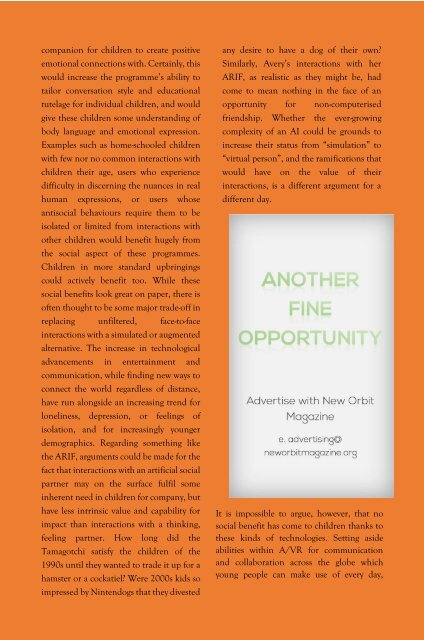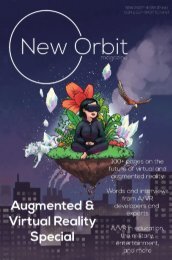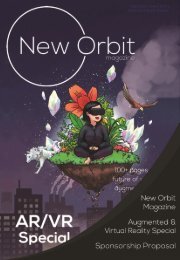Feb 2018 v01 online
((Incomplete formatting))
((Incomplete formatting))
Create successful ePaper yourself
Turn your PDF publications into a flip-book with our unique Google optimized e-Paper software.
companion for children to create positive<br />
emotional connections with. Certainly, this<br />
would increase the programme’s ability to<br />
tailor conversation style and educational<br />
tutelage for individual children, and would<br />
give these children some understanding of<br />
body language and emotional expression.<br />
Examples such as home-schooled children<br />
with few nor no common interactions with<br />
children their age, users who experience<br />
difficulty in discerning the nuances in real<br />
human expressions, or users whose<br />
antisocial behaviours require them to be<br />
isolated or limited from interactions with<br />
other children would benefit hugely from<br />
the social aspect of these programmes.<br />
Children in more standard upbringings<br />
could actively benefit too. While these<br />
social benefits look great on paper, there is<br />
often thought to be some major trade-off in<br />
replacing unfiltered, face-to-face<br />
interactions with a simulated or augmented<br />
alternative. The increase in technological<br />
advancements in entertainment and<br />
communication, while finding new ways to<br />
connect the world regardless of distance,<br />
have run alongside an increasing trend for<br />
loneliness, depression, or feelings of<br />
isolation, and for increasingly younger<br />
demographics. Regarding something like<br />
the ARIF, arguments could be made for the<br />
fact that interactions with an artificial social<br />
partner may on the surface fulfil some<br />
inherent need in children for company, but<br />
have less intrinsic value and capability for<br />
impact than interactions with a thinking,<br />
feeling partner. How long did the<br />
Tamagotchi satisfy the children of the<br />
1990s until they wanted to trade it up for a<br />
hamster or a cockatiel? Were 2000s kids so<br />
impressed by Nintendogs that they divested<br />
any desire to have a dog of their own?<br />
Similarly, Avery’s interactions with her<br />
ARIF, as realistic as they might be, had<br />
come to mean nothing in the face of an<br />
opportunity for non-computerised<br />
friendship. Whether the ever-growing<br />
complexity of an AI could be grounds to<br />
increase their status from “simulation” to<br />
“virtual person”, and the ramifications that<br />
would have on the value of their<br />
interactions, is a different argument for a<br />
different day.<br />
It is impossible to argue, however, that no<br />
social benefit has come to children thanks to<br />
these kinds of technologies. Setting aside<br />
abilities within A/VR for communication<br />
and collaboration across the globe which<br />
young people can make use of every day,










